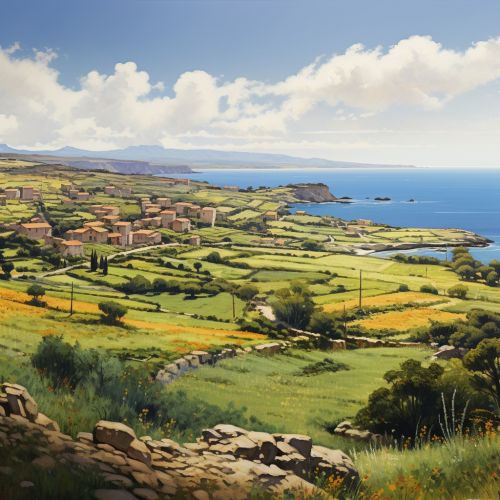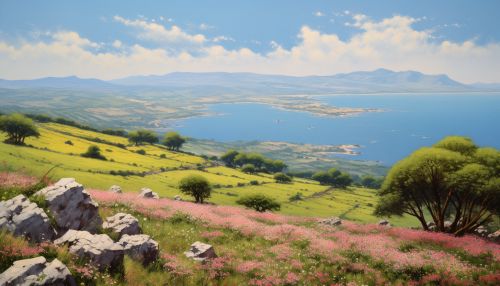Sicily
Geography
Sicily, the largest island in the Mediterranean Sea, is an autonomous region of Italy. It is located to the southwest of the Italian mainland, separated by the narrow Strait of Messina. The island is characterized by a diverse landscape with high mountains, rolling hills, extensive plains and a variety of coastal formations.


Mountains and hills
The island's mountainous terrain is dominated by the Apennine Mountains, which extend into Sicily from the Italian mainland. The highest peak in Sicily is Mount Etna, an active stratovolcano located on the eastern coast of the island. It stands at approximately 3,329 meters (10,922 feet) high, making it the tallest active volcano in Europe and one of the most active in the world. Other notable mountains in Sicily include the Nebrodi and Madonie ranges, which are part of the Sicilian extension of the Apennines.
Plains and valleys
Sicily's plains and valleys are primarily located in the island's interior and along the southern coast. The most extensive of these is the Plain of Catania, a fertile valley located at the foot of Mount Etna. Other significant plains include the Conca d'Oro, a fertile valley known for its production of citrus fruits, and the Plain of Mazara, which is primarily used for the cultivation of olives and grapes.
Coastal formations
Sicily's coastline, which extends for over 1,000 kilometers, is characterized by a variety of formations including sandy beaches, rocky cliffs, and numerous bays and inlets. The island is also surrounded by several smaller islands and archipelagos, including the Aeolian Islands, the Aegadian Islands, the Pelagie Islands, and the islands of Pantelleria and Ustica.
History
Sicily has a rich and complex history, with human habitation dating back to the Upper Paleolithic period. The island has been influenced by a multitude of cultures due to its strategic location in the Mediterranean, including the Phoenicians, Greeks, Romans, Byzantines, Arabs, Normans, and Spaniards, among others.
Ancient history
The earliest known inhabitants of Sicily were the Sicani, who were likely of Iberian or Ligurian origin. They were followed by the Sicels, from whom the island derives its name, and the Elymians, who settled in the western part of the island. The Phoenicians established colonies on the island in the 8th century BC, followed by the Greeks who founded numerous city-states along the eastern and southern coasts. The island became a major center of Greek culture and was known for its wealth and prosperity.
Roman and Byzantine periods
Sicily came under Roman control in the 3rd century BC following the First Punic War. Under Roman rule, the island became an important grain-producing province and was known for its fertile soil and productive agriculture. Following the fall of the Western Roman Empire in the 5th century AD, Sicily was ruled by the Eastern Roman (Byzantine) Empire for several centuries.
Arab and Norman periods
In the 9th century, Sicily was conquered by the Arabs who introduced new agricultural practices and significantly influenced the island's culture and language. The Arab rule lasted for over two centuries until the island was conquered by the Normans in the 11th century. Under Norman rule, Sicily experienced a period of cultural and economic prosperity known as the Sicilian Renaissance.
Modern history
Following the Norman period, Sicily was ruled by a succession of foreign powers, including the House of Hohenstaufen, the Angevins, the Aragonese, and the Spanish. In the 19th century, the island played a key role in the unification of Italy and became an autonomous region of the newly unified Italian state.
Culture
Sicily's culture is a unique blend of influences from the various civilizations that have inhabited the island throughout its history. This is reflected in the island's architecture, language, cuisine, and traditions.
Architecture
Sicilian architecture is characterized by a diverse range of styles, reflecting the island's multicultural history. Notable architectural styles include Greek and Roman classical architecture, Arab-Norman architecture, and Baroque architecture. Key examples of Sicilian architecture include the Valley of the Temples in Agrigento, a UNESCO World Heritage Site featuring some of the best-preserved Greek temples in the world, and the Palermo Cathedral, a stunning example of Arab-Norman architecture.
Language
The official language of Sicily is Italian, however, the Sicilian language, a Romance language distinct from Italian, is widely spoken on the island. Sicilian has been influenced by Greek, Latin, Arabic, French, and Spanish, among other languages.
Cuisine
Sicilian cuisine is renowned for its rich flavors and diverse influences. It is characterized by the use of fresh, local ingredients and a combination of sweet and savory flavors. Notable dishes include arancini (stuffed rice balls), pasta alla Norma (pasta with tomatoes, eggplant, and ricotta cheese), and cannoli (a sweet pastry filled with ricotta cheese). Sicily is also known for its wines, particularly Marsala and Nero d'Avola.
Traditions
Sicilian traditions are deeply rooted in the island's history and cultural heritage. These include religious festivals such as the Feast of Saint Agatha in Catania and the Holy Week processions in Trapani, as well as traditional music and dance forms such as the Sicilian tarantella.
Economy
Sicily's economy is diverse and largely based on agriculture, services, and tourism. The island is known for its production of citrus fruits, olives, wine, and almonds. Sicily's services sector is dominated by retail, health care, and education, while its tourism industry attracts millions of visitors each year, drawn by the island's rich history, stunning landscapes, and vibrant culture.
